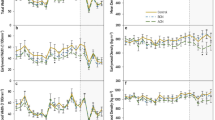Summary
Moose were observed to browse preferentially on balsam fir (Abies balsamea) trees in stands where the stem density had been mechanically reduced to about 2000 stems/ha from over 30,000 stems/ha. Twigs from trees in thinned and unthinned stands were analyzed to test the hypotheses that moose were choosing thinned stands to maximize intake of a nutrient, or avoiding plant secondary compounds deliterious to digestion. Analyses included: twig length, weight, diameter, acid detergent fiber, neutral detergent fiber, dry matter digestibility, macroelements, crude fat (resins), crude protein, ash, and volatile secondary metabolites. Significantly higher concentrations of crude protein, P, Ca, Na, and crude fats occurred in trees from thinned compared to unthinned stands. Twigs from thinned stands were more digestible, longer, heavier, and had a greater diameter than those from unthinned stands. Several secondary metabolites were found in highest concentration in thinned stands. We suggest that moose chose thinned stands over unthinned stands for feeding because of high protein levels and large twigs. Trees in unthinned stands had protein levels below reported maintenance levels required by moose. Secondary metabolite concentrations were opposite to the direction predicted and the data do not support plant defence hypotheses for the chemicals analyzed.
Similar content being viewed by others
References
Association of Official Analytical Chemists (1970) Official methods of analysis. 11th edit Washington, DC
Belovsky GE (1978) Diet optimization in a generalist herbivore: the moose. Theor Pop Biol 14:105–134
Belovsky GE, Jordan PA (1981) Sodium dynamics and adaptations of a moose population. J Mammal 62:613–621
Bergerud AT, Manuel F (1968) Moose damage to balsam fir-white birch forests in central Newfoundland. J Wildl Manage 32:729–746
Bergstrom R, Danell K (1986) Moose winter feeding in relation to morphology and chemistry of six tree species. Alces 22:91–112
Black CA (ed) (1965) Methods of soil analysis, Vol 2. Amer Soc Agron, Madison, WI
Bryant JP, Kuropat PJ (1980) Selection of winter forage by subarctic browsing vertebrates: the role of plant chemistry. Ann Rev Ecol Syst 11:261–285
Bryant JP, Chapin FS, Klein DR (1983) Carbon/nutrient balance of boreal plants in relation to vertebrate herbivory. Oikos 40:357–368
Church DC (1971) Digestive physiology of ruminants, vol. 2. Oregon State Univ, Corvallis OR
Coley PD, Bryant JP, Chapin FS (1985) Resource availability and plant antiherbivore defense. Science 230:895–899
Danell K, Huss-Danell K, Bergstrom R (1985) Interaction between browsing moose and two species of birch in Sweden. Ecol 66:1867–1878
Fraser D, Reardon E (1980) Attraction of wild ungulates to mineral-rich springs in central Canada. Holarct Ecol 3:36–40
Hjeljord O, Sundstol E, Haagenrud H (1982) The nutritional value of browse to moose. J Wildl Manage 46:333–343
Kihara K (1984) Preparation of maltol type flavors from wood leaves and extracts. Nippon Shoyu Kenyusho Zasshi 10:39–42
Klein DR (1970) Food selection by North American deer and their responses to over-utilization of preferred plant species. In: Watson A (ed) Animal populations in relation to their food resources. Blackwell Sci Publ, Oxford, UK, pp 25–44
Kubota J, Reiger S, Lazar VA (1970) Mineral composition Herbage browsed by moose in Alaska. J Wildl Manage 34:565–579
Lavigne MB (1985) Stand density and production processes in balsam fir stands. Ph. D thesis, Yale Univ, New Haven CT
Loyttyniemi K (1981) Nitrogen fertilization and nutrient contents in Scots pine in relation to the browsing preference by moose. Folia Forestalia 487:1–14
Oldemeyer JL, Franzmann AW, Brundage AL, Arneson PD, Flynn A (1977) Browse quality and the Kenai moose population. J Wildl Manage 41:533–542
Owen-Smith N (1982) Factors influencing the consumption of plant products by large herbivores. In: Huntley BJ, Walker BJ (eds) Ecological studies vol 42, Ecology of tropical savannahs. Springer Berlin Heidelberg New York, pp 359–404
Owen-Smith N, Novellie P (1982) What should a clever ungulate eat? Am Nat 119:151–178
Parker GR, Morton LD (1978) The estimation of winter forage and its use by moose on clearcuts in northcentral Newfoundland. J Range Manage 31:300–304
Peek JM (1974) A review of moose food habits studies in North America. Nat Can 101:195–215
Pyke GH, Pulliam HR, Charnov EL (1977) Optimal foraging: a selective review of theory and tests. Quart Rev Biol 52:137–154
Regelin WL, Schwartz CC, Franzmann AW (1987) Effects of forest succession on nutritional dynamics of moose forage. Swed Wildl Res [Suppl] 1:247–264
Reichardt PB, Bryant JP, Clausen TP, Weiland GD (1984) Defence of winter-dormant Alaska paper birch against snowshoe hares. Oecologia 65:58–69
Robbins CT (1983) Wildlife feeding and nutrition. Academic Press, NY
Roberts BA (1983) Soils. In: South Gr (ed) Biogeography and ecology of the island of Newfoundland. Junk, The Hague, pp 107–161
Rudolph E von, Granat M (1982) Seasonal variation of the terpenes of the leaves, buds, and twigs of balsam fir. Can J Bot 60:2682–2685
Schoener TW (1971) Theory of feeding strategies. Ann Rev Ecol Syst 2:369–404
Schwartz CC, Regelin WL, Franzmann AW (1987) Protein digestion in moose. J Wildl Manage 51:352–357
Thompson ID (1988) Moose browsing damage in pre-commercially thinned balsam fir stands in central Newfoundland. Alces 24: 56–61
Tilley JMA, Terry RA (1963) A two-stage technique for the in vitro digestion of forage crops. J Brit Grassland Soc 18:104–111
Tyukavkina NA, Medvedeva SA, Ivanova SZ, Voronov VK (1972) Maltol from Abies sibirica leaves. Khim Prir Soedin:674–675
Van Soest PJ, Wine RH (1967) Use of detergents in the analysis of fibrous feeds. IV. Determination of plant cell wall constituents. J Assoc Off Anal Chem 50:50–55
Vivas HJ, Saether BE (1987) Interactions between a generalist herbivore, the moose, and its food resources: an experimental study of winter foraging behaviour in relation to browse availability. J Anim Ecol 56:509–520
Westoby M (1974) An analysis of diet selection by large generalist herbivores. Am Nat 108:290–304
Author information
Authors and Affiliations
Rights and permissions
About this article
Cite this article
Thompson, I.D., McQueen, R.E., Reichardt, P.B. et al. Factors influencing choice of balsam fir twigs from thinned and unthinned stands by moose. Oecologia 81, 506–509 (1989). https://doi.org/10.1007/BF00378960
Received:
Accepted:
Issue Date:
DOI: https://doi.org/10.1007/BF00378960




